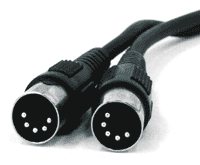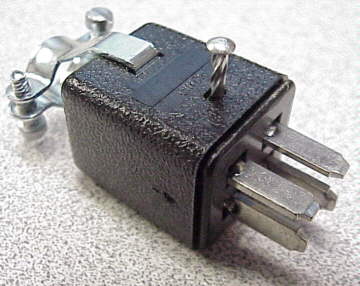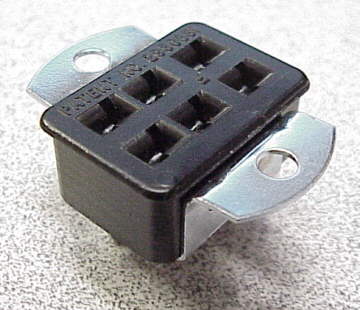|
Do you want to be a better CNC'er in 37 Seconds? Get Better Tool Life, Surface Finish, and Material Removal Rates Fast. It's that easy. You can install and get results now. |
CNC Machine Noise Cures
After backlash, the second biggest source of frustration seems to be noise problems on home brew CNC systems. Noise can manifest itself in a variety of ways including uncommanded movements, servo encoder problems, and limit switches tripping unexpectedly. There are many noise sources, but motors and VFD's appear to be the worst. Any source of electrical sparks or arcing is going to make noise. In fact, the first radio transmissions were nothing more than great big sparks!
Noise suppression is often a matter of surrounding the noise producers and/or the noise victims with a grounded metal shield. With enough foil and grounding, you can shield anything from noise:

With enough foil and grounding, you can shield anything from noise!
Fortunately, there are easier ways, so put away your aluminum foil and read on. Below is a laundry list of tips I've come across that you can consider and try if you think you're having a noise problem.
Important Preventative Tips
These are the things you should always do as you're building the system to avoid having to deal with noise later on. They're either mandatory or so cheap and easy you may as well do them anyway.
Use an Opto-Isolated Breakout Board
Your CNC electronics and your PC are each a source of noise as well as being vulnerable to noise from the other. Putting each into its own grounded chassis will help keep them isolated and the opto-isolators help keep them isolated.
Use Shielded or Twisted Pair Cables
Shielded cabling for the stepper/servo motor wiring, encoder wiring, and limit switch wiring is ideal for noise resistance.
I bought a 500' spool of 6 conductor shield 22 AWG cable from Action Electronics (No longer in business, unfortunately). For connectors, I'm using some microphone connectors, also from Action Electronics:
6 conductors and a foil shield: this is the right cable for my step motors!
For others who may read this, you want to use shielded cables or noise will make your system unreliable. FWIW, when I first got my limited switches going, I did not ground the cable shields to the CNC cabinet. As a result, I had a bogus limit fire about every 2 to 3 minutes. Grounding the shields made that go away completely. If you didn't think you had noise in your system, maybe it was because you didn't have a way to check?
Other thoughts:
- You can use CAT-5 cable for encoders or limit switches, just be sure you use the twisted pair feature and pair each signal with it's ground to provide noise immunity. Apparently this idea has been blessed by none other than Mariss F., Mr Gecko, himself.
- DIN cables such as are used as MIDI patch cables in the music business and older keyboard cables (before the PS/2 and USB styles) in the PC business are another possibility. Even Radio Shack carries some DIN cable componentry. DIN for MIDI applications have 5 conductors plus a ground/shield and are supposed to be rated to 2 amps @ 100V. What's nice is you can get premade DIN cables in a variety of colors and lengths. If they'll serve the power needs of your system, they could be quite convenient. Mini-DIN is the PS/2 keyboard connector, and is also shielded. It might be useful for limits and encoders. Cables are available already made up. Note that Homann sells a mini-DIN breakout board that would make it easy to connect to your mini-DIN cables with point to point wiring.

MIDI DIN patch cable...
- Cinch connectors are another common type of connector used for motors. They will carry a bit more current than DINs or microphone connectors.


Cinch connectors...
Higher Voltage Control Signals Have Better Noise Immunity
3-5V DC is pretty marginal from a noise immunity standpoint. If you can run 12V or more to your limit switches you will find it is much less susceptible to noise. Unfortunately, this may be difficult to change as your breakout board will likely have made the voltage decision for you. My GRex uses 12V.
Sometimes you can use a Zener diode to run a higher voltage and convert it back to 5V for your breakout board. Run a 24V circuit and have the switch ground that. Then use a resistor in series something like 1K to the digital input, with a 5V1 zener diode across the input and ground. (Bar of diode to input). The Zener diode will clamp the digital voltage at 5volts.
There are also opto-isolators that allow differential voltages so you could have +5V to your breakout (actually may as well go to the parallel if you are using an opto-isolator--don't need 2 of them!) and 24V to your switch circuits.
Higher Current Helps Too!
If you can not up the voltage try putting some 100 ohm pull up resistors to +5 on the switch, this will give you 50 milliamps of current through the switch and may help increase reliability. This is .250 watts so get ½ watt resistors or they will get warm.
Wire Home and Limit Circuits Normally Closed
Noise spikes are usually positive, so a normally open circuit can see a noise spike as circuit closure. Wire the circuits normally closed and they're less susceptible. Most of the time normally closed is a good idea from a reliability standpoint too as any damage to the circuit usually opens it and trips the circuit.
Keep "Noisy" Wires Aways from "Quiet" Wires
For example, don't run the limit wiring in the same conduit as the cable from VFD to motor! When noisy wires must be near quiet wires, try to cross them at right angles rather than running them parallel. Parallel wires are good at passing noise to each other.
Separate Chassis for PC, Driver Electronics, and VFD
Put each of these components into its own chassis (don't just stick your VFD in a box next to a bare PC motherboard, next to a bare breakout board, next to bare servo drives), and then run a common ground to each chassis.
VFD Noise
If you were asked to produce a noise generator in order to sabotage a CNC or other sensitive electronic system, you couldn't ask for a more efficient one than a VFD!
A grounded flexible metal conduit is very desirable with the VFD connection to the motor. T&B SuperFlex also has a small copper wire wound with the metallic sheath for ground continuity. Use of twisted conductors inside the flex conduit will also help reduce the noise emissions from the VFD.
Keep the wiring length from VFD to motor as short as possible. Long lines can radiate more noise.
VFD manufacturers like Hitachi sell special filters called EMI, RFI, or EMC filters that cut out noise. They're installed on the AC mains side of the VFD. They also sell line reactors that go on the line between the VFD and the motor. A line reactor reduces noise by cutting out harmonics, and it will also increase the performance of the system since power is being lost through the harmonics. Outfits like AutomationDirect sell them, but they aren't cheap so I wouldn't necessarily add one unless you were running out of noise reduction steps to try.
Avoid Ground Loops
If you're familiar with ground loops and their impact on stereos and hi-fi equipment, you know they are a source of noise. Ground loops occur when all grounds are not quite a the same zero potential. The best way to avoid them is to use a common ground for all equipment. The exception to this rule is when using a plasma cutter you will want to keep the grounds for the plasma cutter separate from the rest of the equipment all the way back to the mains box if possible.
Diagnosis and Even More Noise Tips
Be sure to check out G-Wizard, our Machinist's Software!
|
Do you want to be a better CNC'er in 37 Seconds? Get Better Tool Life, Surface Finish, and Material Removal Rates Fast. It's that easy. You can install and get results now.
|
||||||||||||||||||
| ||||||||||||||||||